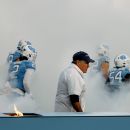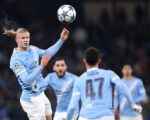POCATELLO and MOSCOW, Idaho — In remote stretches of I-84 between Boise and Pocatello in southern Idaho, the speed limit is 80 mph. It wouldn’t be unusual to set the cruise control to 90 and not worry about a speeding ticket. But in 2023, when Maclane Westbrook was a student at Idaho State, he blew past a state trooper sitting in the median and his speedometer read triple digits.
«I didn’t even try to slow down,» Westbrook said.
Westbrook was driving an ISU-issued car — with university insignia on the side — and was on his way back to campus from a board of educators meeting in the state capital and was quickly pulled over.
As Westbrook searched for an explanation that might possibly get him out of the ticket, a puzzled look overtook the trooper’s face. Sitting on the lap of Westbrook’s friend riding shotgun was a bald, silver-colored potato wearing a dry human smirk.
«You got a pottery project there?» the trooper asked.
This is how Westbrook found himself telling the story of the King Spud trophy — a long-lost relic in the Idaho-Idaho State rivalry — on the side of the highway, with hope its lore would inspire the trooper to issue just a warning. The tale did not have the desired outcome, and when the trooper retreated to his car to write the ticket, Westbrook’s friend noticed King Spud’s crown had been sitting on the floor mat. While they waited, he fixed it back on the trophy’s head.
When the trooper returned, he was perplexed yet again.
«Hey, he wasn’t wearing a crown when I was here the first time,» he said.
For Westbrook, it was an awkward traffic stop. For King Spud, it was just another chapter in an already bizarre existence. Because sometime around 1979, long before a replica of the original trophy found itself in the front seat of an Idaho State fleet car, baffling a state trooper, the original King Spud quietly and mysteriously vanished entirely. And for decades, no one seemed to care.
Born as a quirky art project at the University of Idaho in the early 1960s, the trophy’s vanishing act is one of the stranger mysteries in college sports. Over the past four decades, others have tried to track it down. This year, ESPN set out on its own adventure through Idaho’s small towns and college campuses, following decades of faint clues to determine what really happened to the lost King Spud — and whether it might still be out there.


1 Related
The Vandals remained in the Big Sky until 1996, when they left for the Big West and for two decades tried to make football work at what is now the FBS level. But the geography — among other reasons — didn’t allow it to work. Idaho returned most of its sports to the Big Sky in 2014, and football returned to the conference in 2018, where the school again competes with more natural peers.
In 1968, Alford was preparing to hit the road for a neutral-site basketball game against Idaho in Twin Falls when he was approached by his boss.
«He says, ‘You’ve got to take the King Spud trophy with you.’ And I said, ‘What is the King Spud trophy?'» Alford recalls. «I’d never seen it. Never heard of it.»
The King Spud trophy was commissioned by the Moscow Chamber of Commerce in 1962 with the idea it would be awarded annually to the winner of the Idaho-Idaho State men’s basketball game or series.
For at least 17 years, that’s what happened, with the trophy bouncing back and forth between Moscow and Pocatello.
The state was not exactly a basketball mecca during this period, but the Bengals delivered one of the great moments in Big Sky history in 1977 when they beat UCLA in the Sweet 16 of the NCAA men’s basketball tournament. The upset ended the Bruins’ run of 10 consecutive trips to the Final Four and sits alongside Idaho State’s 1981 Division I-AA football national title as the greatest achievement in school history.
Alford admits he didn’t have an affinity for the King Spud trophy, nor did anyone else the way he remembers it. He never wrote about it in news releases, and it was something of a nuisance because of how heavy it was — Alford estimates it weighed about 25 pounds — making it difficult to lug around.
personal curiosity — part football stadium, part indoor track, part architectural experiment, part fever dream. Assistant athletic director Jerek Wolcott weaved us through halls that felt more like the underbelly of a ship than the guts of a stadium. He unlocked a cement-walled room tucked behind one of the end zones. Dust coated everything. Cardboard boxes were filled with trophies dating back to the 1930s. No spud.
We climb a hidden set of stairs and a ladder into the rafters, where we can peer through the slats in the roof onto the field below. There is, of course, no logical reason King Spud would be here, but common sense has long been lost. And the view of the Palouse from the roof ends up being worth the climb.
With no luck inside the Kibbie Dome, the next logical step was to meet with the person who helped resurrect King Spud in the first place.
Casey Doyle is a professor of art and design at the University of Idaho, and during a quiet summer a few years ago someone from the library approached him with an unusual request: Could he re-create a long-lost potato-shaped rivalry trophy so the school could display it in the library?
The project was outside his normal artistic lane. He’s not a sports fan, and Doyle’s background blends traditional sculpture with performance-based work and nontraditional materials, but the idea of re-creating a decades-old trophy born from student folklore was interesting enough for him to take it on.
Doyle began with the few photographs that exist of the original King Spud. Working in clay made the most sense given the budget and his expertise. He blocked out a solid clay potato first, shaping its rounded form, then gradually carved in the signature elements: the smirking face, the rounded head, the base beneath it and the simple crown that once sat atop the original.
Once the exterior form looked right, he cut the sculpture cleanly down the middle and hollowed it out so it wouldn’t explode during firing. The base was thrown separately on a pottery wheel. After firing, it became the new physical reference point for the trophy’s rebirth.
The library then had Doyle’s sculpture 3D-scanned so it could produce small replica keychains. Doyle assumed that was the extent of its use. Until we met in the library a few feet from where his clay version is on display. Doyle had no idea it had also been 3D printed to be put back in circulation as a rivalry trophy.
By this point, the mission had shifted. Finding the original King Spud felt unlikely; understanding its lore was essential. And in Moscow, there was only one place to go for that — the Corner Club, the town’s legendary sports bar.
In the middle of a weekday afternoon, the place was empty. Marc Trivelpiece, the owner since 2007, stood behind the bar wiping down glasses. One of the King Spud keychains is on display and another depiction of the trophy is on the wall.
Trivelpiece didn’t need much prompting to dive into the mystery. His theory about the missing trophy mirrored the most common one: Someone tossed it decades ago.
«Where else would it have gone?» he asked. «We’ve been looking for it for years — at least we have. I don’t know how much effort Idaho State put into looking for it.
«It could have been somebody took it home and then it got put in the back of a closet and they passed away and their kids didn’t know what it was. They got rid of it. Who knows.»
At Corner Club, the lore of King Spud lived on. And maybe that would have to be enough.
A HANDFUL OF follow-up calls after the Idaho quest didn’t uncover anything new. At some point, the odyssey stopped being about finding a missing object and became a question about why anyone would care this much about a decades-old potato trophy in the first place.
Maybe the answer is simple: Rivalry trophies are fun. Even the clothing company Homefield Apparel has embraced the lore, selling a King Spud T-shirt. Trophies can be quirky, tangible excuses for schools to argue about bragging rights, to tell old stories, to let a football game or basketball series feel like it carries just a little more weight than the standings say it does.
That became clearer when Idaho State revived not just King Spud, but a trophy it didn’t even know it had lost. In the wake of King Spud’s resurrection, Thiros asked Westbrook if he had any other ideas in the spirit of King Spud.
«Well, there’s the Train Bell Trophy. It’s down at Weber State collecting dust,» he said.
The bell wasn’t missing so much as forgotten, tucked away somewhere at Weber State since it was last awarded in 1973.
«So for two years we kind of had discussions with Weber State about, let’s bring back the Train Bell,» Thiros said.
Finally, Idaho State stopped waiting. The school announced unilaterally that the Train Bell Trophy was returning, and when the Bengals won in Ogden, Utah, for the first time in 40 years, the offensive line lugged the heavy bell to a roaring ISU student section.
The same pattern repeated itself in the Idaho-Idaho State football rivalry. Since 2018, the schools had played for the Battle of the Domes Trophy, but a corporate sponsorship change led to its quiet retirement after the 2022 season. Suddenly, football had no symbol at all.
For the 2023 meeting, then-Idaho head coach Jason Eck refused to let the game go trophy-less. He cobbled together a temporary Potato State Trophy by attaching a Mr. Potato Head to the Battle of the Domes base. It was goofy and earnest.
Last year, Wolcott created a permanent fix. He carved the official Potato State Trophy out of north Idaho Douglas fir, a straightforward, sturdy replacement for a rivalry that has never taken itself too seriously. Idaho won last year, but on Saturday the Bengals beat the Vandals 37-16 to claim the trophy, uniting it with King Spud for the first time.
The original King Spud remains missing — maybe in a landfill, maybe truly gone. If anything, the hunt for something lost ended up bringing more traditions back into the light. Rivalry trophies survive not because they endure, but because people keep deciding they still matter.






